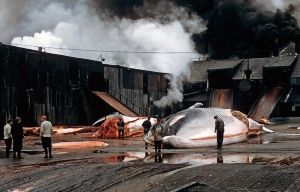Did you know that Norway’s first oil boom was in Antarctica?
More specifically in the Southern Ocean, from which incredible amounts whale oil were extracted between 1905 and 1940.
 Whale on the flensing deck in Husvik, South Georgia, in 1956. Photo: John Snuggerud / Norwegian Polar Institute
Whale on the flensing deck in Husvik, South Georgia, in 1956. Photo: John Snuggerud / Norwegian Polar Institute
Norwegian whaling began in the north, in the waters around Svalbard and off the coast of Finnmark and Troms. But the whale population eventually came under threat and in 1903, whaling was banned in Norway. By then, whales had essentially disappeared. In 1901–1903, C.A. Larsen – who had been a whaler in Finnmark – sailed for Antarctica with a Swedish expedition under Otto Nordenskiöld. Larsen observed that whales were plentiful in the areas around South Georgia, and building on his experience from the north, he established the whaling station Grytviken on South Georgia in 1904, with good financial support from Argentina. This marked the dawn of modern whaling in Antarctica.
Initially, land stations were established on South Georgia and Deception Island. When whales started to disappear from nearby waters, floating refineries were built, ships that lay in calm waters where whale oil could be rendered from the blubber. Only the oil and the baleen were used. Whale oil was in great demand to make soap and margarine, and baleen was used in corsets.
Small whale-chasing boats were deployed from the refinery to capture the whales. When a whale had been harpooned, the carcass was filled with air to keep it afloat, and marked with shipping company’s flag. Later the carcasses were collected and towed to the refinery ship where they were flensed alongside the ship, and the blubber was hauled aboard to be rendered. Eventually whaling became an entirely off-shore activity, centred on factory ships with a wide range of action. These ships could spend an entire season whaling on the open seas independently of land bases, which meant that the shipping companies did not have to pay fees to stations with licenses. At the stern of these factory ships was a slipway up which the whale carcass could be hauled.
Anders Jahre commissioned construction of the first custom-built factory ship, Kosmos I, on which five whales could be flensed simultaneously, the oil rendered and with enough space left over on deck for a seaplane. The ship was costly to build, but it was paid for in two years.
As many as 10,000 Norwegians were involved when the industry was at its peak. They worked for the shipping companied in Vestfold, but also for foreign shippers. It was a tough, dangerous job. Between 1903 and 1923, two thousand whaling men were lost in Antarctica. The workdays were long – 70-hour weeks were not uncommon – and the work was physically demanding. The noise at whaling stations and refineries was cacophonous and the slippery blubber made the flensing deck treacherous. Those who worked there had to put spikes in their boots just to be able to stay on their feet. The pay depended on how many whales they had caught and what tasks they had done. A good harpooner was highly valued – and well paid.
Norwegian whalers accounted for 70 % of all whale hunting in Antarctica at the end of the 1920s. In 1929, right whale hunting was banned, and with time additional Norwegian and international resource management regulations were put in place. Norwegian participation in Antarctic whaling ended in the 1960s.